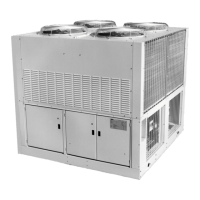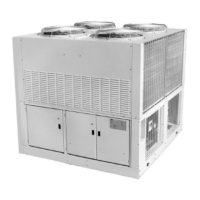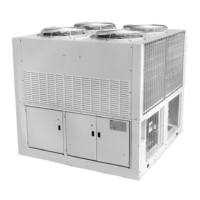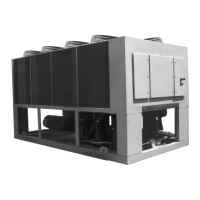IOMM AGZB1 AGZ 010B through 034B 7
Chilled Water System
Water Piping
Local authorities can supply the installer with the proper building and safety codes required
for proper installation.
Install piping with minimum bends and changes in elevation to minimize pressure drop.
Consider the following when installing water piping:
1. Vibration eliminators to reduce vibration and noise transmission to the building.
2. Shutoff valves to isolate the unit from the piping system during unit servicing.
3. Manual or automatic air vent valves at the high points of the system. Install drains at
the lowest points in the system.
4. Maintaining adequate system water pressure (expansion tank or regulating valve).
5. Temperature and pressure indicators located at the unit to aid in unit servicing.
Pressure gauge taps must be installed in the chilled water inlet and outlet piping or as
shown in Figure 4.
6. A strainer or other means of removing foreign matter from the water before it enters the
pump. Place the strainer far enough upstream to prevent cavitation at the pump inlet
(consult pump manufacturer for recommendations). The use of a strainer can prolong
pump life and keep system performance up.
7. A 40-mesh strainer is required in the water line just before the inlet of the evaporator.
This will help prevent foreign material from entering and decreasing the performance
of the evaporator.
!
CAUTION
If a separate disconnect is used for the 110V supply to the evaporator heating cable,
mark the disconnect clearly so the disconnect is not accidentally shut off during cold
seasons. Failure to do so can cause a failure of the evaporator.
8. The brazed plate evaporator has a thermostat and heating cable to prevent freeze-up
down to -20°F (-29°C). The heating cable should be wired to a separate 110V supply
circuit. As shipped from the factory, the heating cable is wired to the control circuit.
Protect all water piping to the unit from freezing.
9. If the unit is used as a replacement chiller on a previously existing piping system, flush
the system thoroughly before unit installation. Perform regular water analysis and
chemical water treatment on the evaporator immediately at equipment start-up.
10. When glycol is added to the water system for freeze protection, the refrigerant suction
pressure will be lower, cooling performance less, and water side pressure drop greater.
If the percentage of glycol is high, or if propylene is used instead of ethylene glycol, the
added pressure drop and loss of performance could be substantial. Reset the freezestat
and low leaving water alarm temperatures. The freezestat is factory set to default at
38°F (3.3°C). Reset the freezestat setting to approximately 4 to 5 degrees F (2.3 to 2.8
degrees C) below the leaving chilled water setpoint temperature. See the section titled
“Glycol Solutions” on page 10 for additional information concerning glycol.
11. Perform a preliminary leak check before insulating the piping and filling the system.
12. Include a vapor barrier on the piping insulation to prevent condensation and possible
damage to the building structure.

